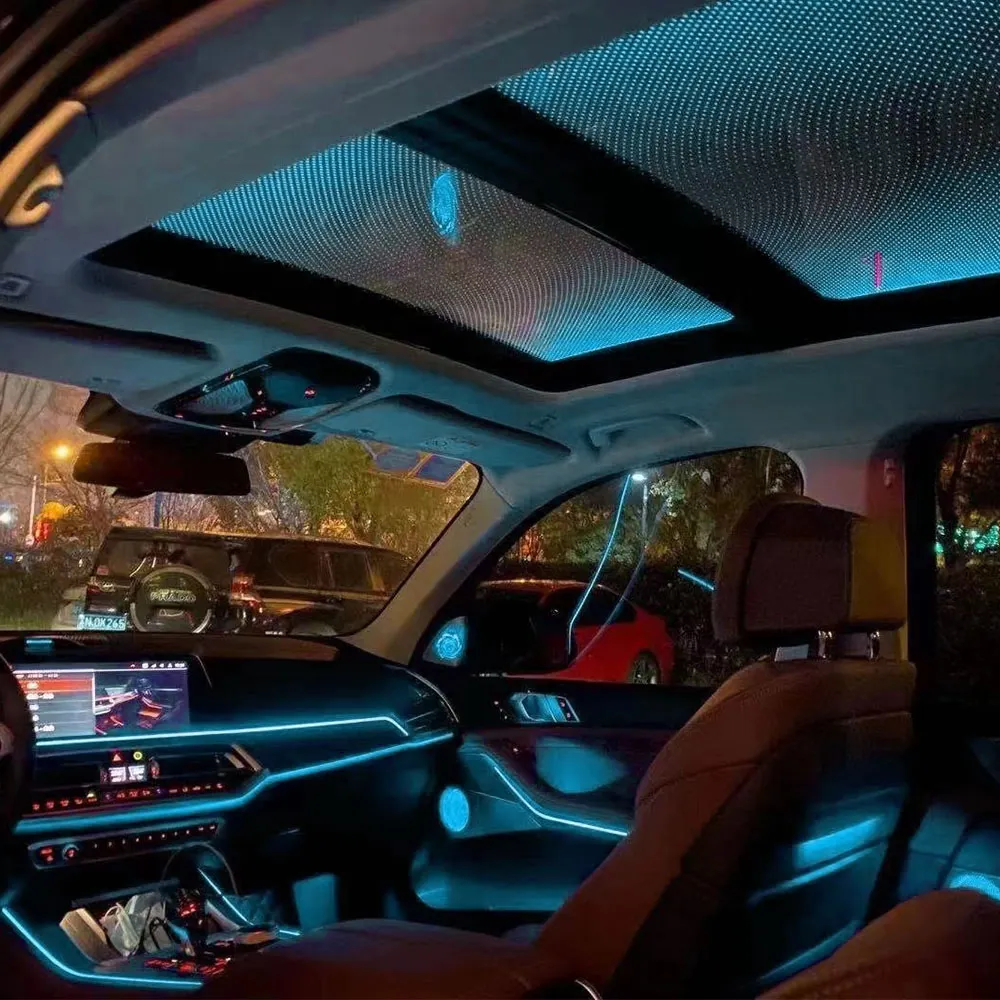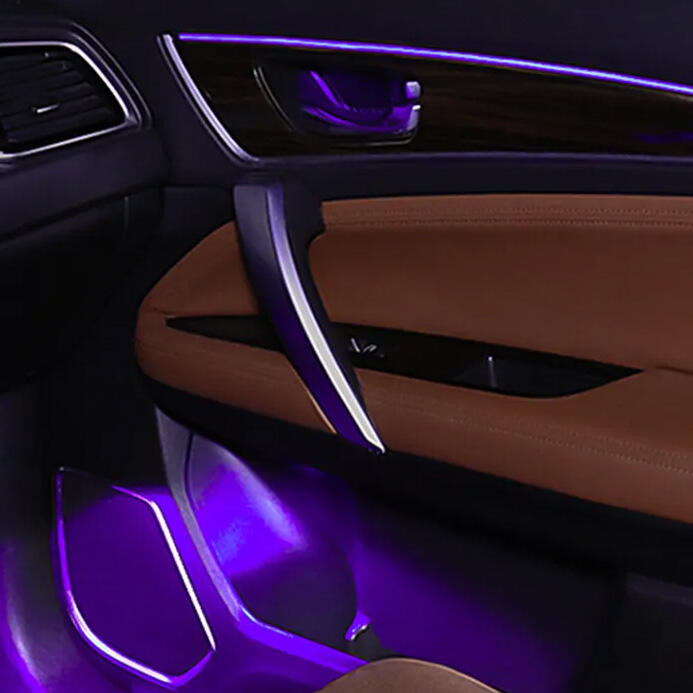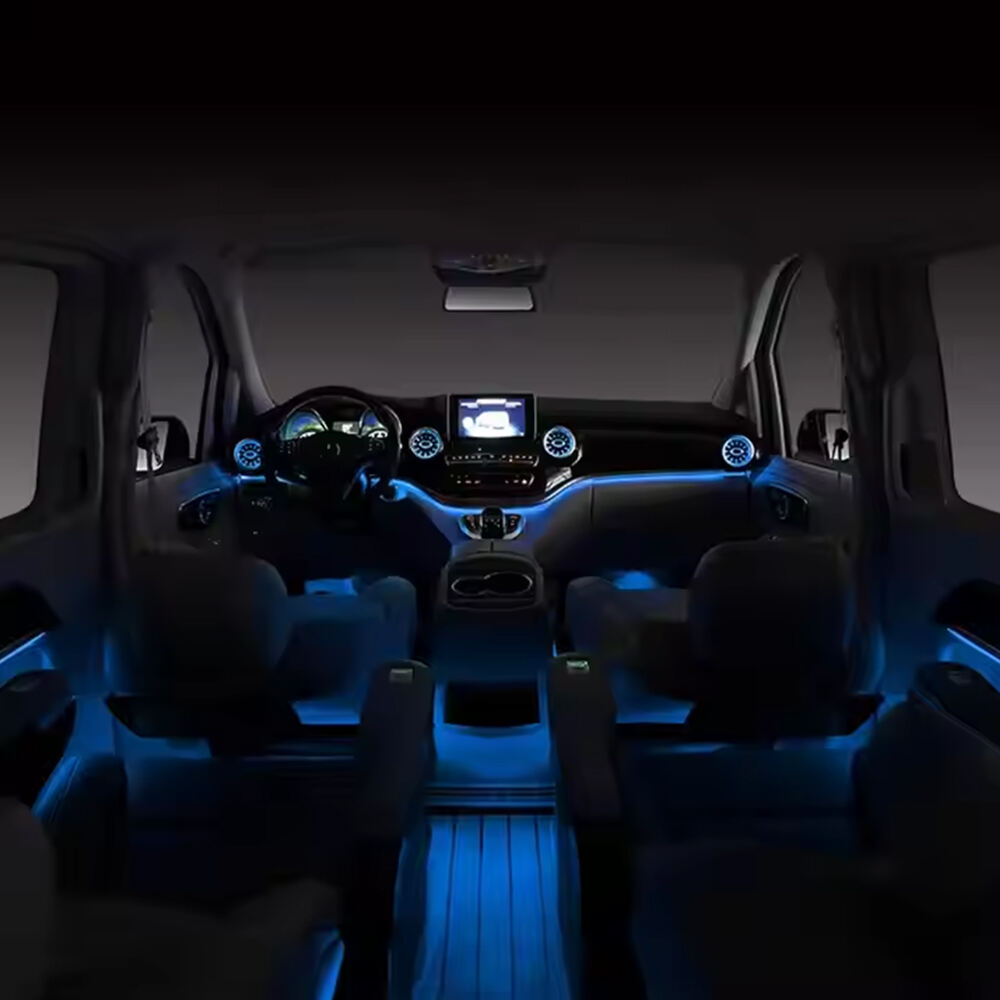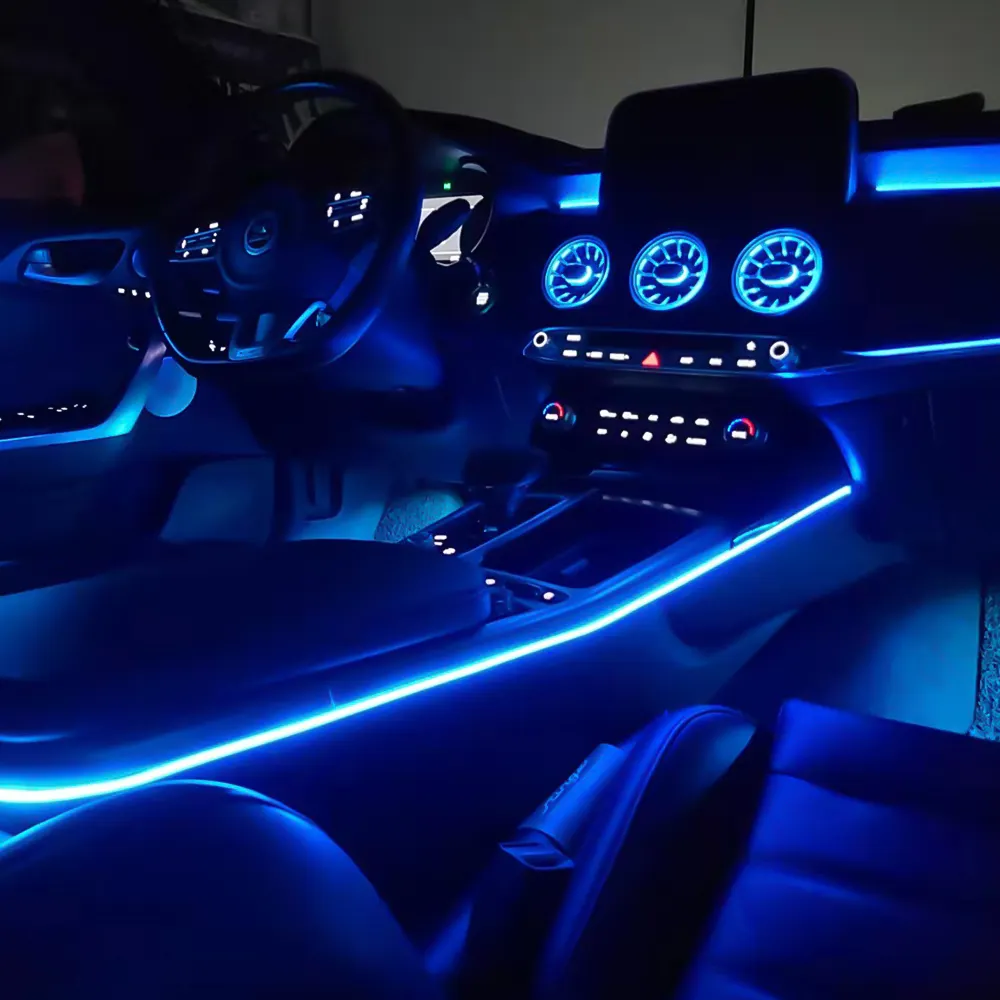The Evolution and Impact of Mercedes Ambient Light in Luxury Vehicles
What Is Mercedes Ambient Light and Its Role in Modern Interiors
The Mercedes ambient lighting system is basically a set of customizable LED lights that do double duty by making the car look nicer inside while actually helping drivers see better at night too. These RGB LEDs (those red green blue ones) are positioned all around the cabin so they can cast different colors on things like door panels, underfoot areas, and even parts of the dashboard. A recent survey from J.D. Power back in 2023 found something interesting: almost seven out of ten luxury car shoppers care about these ambient lights because they make the whole driving experience feel more upscale and comfortable when it gets dark outside. The way these lights gently illuminate the interior details helps reduce glare on controls and makes everything look more expensive than it might otherwise seem just sitting there in the daylight.
Technological Advancements in Premium Car Lighting (2020–2025)
Car lighting isn't what it used to be anymore. Back in the day, we had those basic single color systems, but now we're seeing something much smarter happening in the industry. Take Mercedes for instance they've started incorporating RGBW LEDs into their designs. These little components bring in those sharp white tones that really pop against other colors, making everything look clearer on the dashboard. The new 2025 E-Class model takes things even further with these fancy laser etched guides that create all sorts of interesting pattern effects inside the cabin. And get this some of the next generation cars will actually adjust their brightness based on what outside conditions are like thanks to built-in sensors and artificial intelligence working behind the scenes. According to folks who watch this market closely, sales of these smart lighting systems should grow around 24% each year until at least 2025. People want their cars to reflect their personalities these days, plus there's growing interest in how these lights can work together with safety features like lane departure warnings and automatic braking systems.
How Ambient Lighting Enhances Mood, Aesthetics, and Driver Experience
The carmaker has been playing around with color psychology for years now, especially with their impressive range of 64 colors. Cool blue tones tend to keep drivers more alert when they're cruising down highways, whereas those warm amber shades actually cut down on driver fatigue during nighttime drives. According to recent Euro NCAP crash test results from 2024, cars that come with this kind of adaptive ambient lighting saw about 15 percent improvement in how quickly people reacted to hazards when visibility was poor. Another nice touch is these precision dimming areas that really cut back on annoying glare from both windows and dashboards something that used to drive many drivers crazy in older models.
Integration of Mercedes Ambient Light with Infotainment and Climate Systems
The latest car models come with ambient lighting that works hand in hand with all sorts of cabin features through the MBUX system. When someone turns on climate control, the air vents start glowing softly in blue tones. Navigation warnings show up as gentle pulses near where the driver looks without being distracting. Even the music gets involved somehow, turning those deep bass notes into actual light shows across the dashboard. According to some research from 2024 looking at how people interact with vehicles, this kind of sensory teamwork cuts down mental strain by about a fifth when compared to older cars with separate controls everywhere. Makes sense really, since everything just flows together instead of fighting for attention.
How 3D Audio Technology Elevates the In-Car Listening Experience
Understanding 3D Speaker Systems and Spatial Sound Design
Today's 3D speaker tech relies on digital signal processing (DSP) along with careful positioning of speakers around the room to produce those amazing surround sound effects we all love. Traditional stereo setups just can't compete because modern systems actually move sound around the listener space. Audio comes from above our heads, behind us even, thanks to smart algorithms that mimic how sound behaves in real life spaces. The system tweaks when each channel plays and how loud it gets, creating an almost movie theater quality experience where we can tell exactly where a sound is coming from. This matters a lot for different content types too music feels more alive, podcasts become more engaging, and even GPS directions sound more natural. We're seeing this kind of tech becoming standard in car audio systems as manufacturers race to offer passengers richer, more realistic listening experiences inside vehicles.
3D vs. Stereo and Traditional Surround Sound: Key Differences
Regular stereo systems basically split sound between left and right channels only. Traditional surround sound setups take things further by adding speakers behind the listener for some basic directionality. Now 3D audio takes spatial sound to another level entirely. It places sounds not just left/right but also above and below us through special overhead speakers or those that fire upwards from existing ones. Formats such as Dolby Atmos work differently too. Instead of fixed channels, they map individual sounds to specific spots in space so those sounds can actually move around freely while watching a movie or playing games. The result? Much better overall clarity without that tired feeling after extended listening sessions, plus it makes conversations much easier to follow even when driving for hours at a time.
Burmester 3D Surround Sound in Mercedes-Benz: A Benchmark Example
Mercedes-Benz has something special going on with their Burmester 3D Surround Sound system in certain models. Talk about setting the bar pretty high for car audio systems! The setup comes with no fewer than 27 speakers, some even mounted in the ceiling, which creates this amazing 360 degree sound field throughout the cabin. What's really neat is how the system constantly tweaks itself based on what's happening inside the car right now. It listens to things like how quiet or noisy the interior gets, changes in road conditions, where people are sitting, all while adjusting frequencies accordingly. And when paired with those ambient lights we've come to expect from Mercedes, there's an extra layer of atmosphere added too. Cool blue lighting pops up during Focus mode, while warmer colors take over when switching to Relax mode. These little touches create these really immersive experiences that just feel like what luxury should be these days.
Sensory Synergy: Combining Mercedes Ambient Light with 3D Audio for Immersion
The luxury car market is transforming into something beyond just transportation these days. Light and sound are becoming partners in creating experiences inside the vehicle cabin. According to recent data from the Luxury Vehicle Report 2024, around 78 out of every 100 people buying luxury cars consider the atmosphere inside almost as crucial as how well the car performs on the road. Mercedes-Benz stands at the forefront of this trend, combining their signature ambient lighting systems with advanced 3D audio technology. They've even started incorporating concepts from neuroscience research to make drivers feel more connected emotionally while staying aware of what's happening around them during drives.
The Science of Multisensory Integration in Vehicle Cabins
Research suggests our brains work about 40 percent quicker when processing both light and sound together compared to when they're separate according to a study published in the Journal of Automotive Engineering back in 2023. Mercedes has taken notice of this phenomenon and incorporated it into their vehicle designs through something called adaptive RGB lighting that works hand in hand with their 3D audio systems. Think about what happens during a musical performance inside the car cabin. When someone plays a delicate violin piece, the interior lights might shift to gentle amber tones around the doors. But then comes those powerful bass lines, and suddenly the floor starts pulsing with light in rhythm with each beat. This kind of synchronized experience doesn't just look cool it actually helps drivers stay more alert and aware of their surroundings while enjoying music at the same time.
Synchronizing Light and Sound for Emotional and Cognitive Impact
Harmonized light-audio pairings reduce driver fatigue by 32%, according to research by the Society of Automotive Engineers. Mercedes’ system uses its 64-color ambient palette to reinforce audio signals—blue pulses for navigation prompts, warm gradients during hands-free calls. This bi-sensory feedback improves reaction times by 0.2 seconds in simulated driving conditions.
AI-Powered Personalization of Light-Audio Profiles
The MBUX AI in Mercedes cars gets to know what people like over time, changing things like the lights in 15 different areas and tweaking the sound across 31 speakers. Someone who often listens to jazz music when it's dark outside will find the car naturally switches to deeper blue tones and lower light levels. There are also sensors inside that pick up on body signals such as heart rate changes while people sit there. Early test versions have managed around plus or minus 12 percent accuracy when adapting to someone feeling stressed out or relaxed during their drive.
Customization Options for Mercedes Ambient Light and Audio Settings
Personalizing Color, Intensity, and Lighting Zones
Drivers can tailor ambient lighting across three dimensions:
- Color: Choose from over 60 hues to suit mood or occasion
- Intensity: Adjust brightness via intuitive sliders for optimal visibility and comfort
- Zones: Control specific areas footwells, door panels, dashboards—for layered effects
This level of customization turns the cabin into a responsive, personalized space where design supports both emotion and function.
Scene Based Presets: Adapting Ambience to Driving Modes or Time of Day
Advanced systems use contextual triggers to automate lighting and audio settings:
- Drive modes: Sport mode activates bold red accents; Comfort shifts to soft gold tones
- Time awareness: Sunset themes blend warm oranges into the cabin, mirroring natural light changes
- Music sync: Bass-heavy tracks generate pulsating light patterns in rhythm with the beat
These presets minimize manual input while deepening immersion.
Types of Ambient Lighting Technologies: LED, RGB, and Fiber Optic
| Technology | Key Traits | Application Example |
|---|---|---|
| LED | Energy-efficient, 16M color spectrum | Door handle highlights |
| RGB | Tunable white balance & saturation | Overhead console mood lights |
| Fiber Optic | Even glow for large surfaces | Dashboard contour lighting |
By combining these technologies, Mercedes creates depth and dimensionality without glare—ensuring visual comfort and maintaining driver focus at night.
Designing an Immersive Driving Environment: Balance and Future Trends
Maximizing Comfort and Focus Through Balanced Sensory Design
Mercedes ambient light systems exemplify how sensory inputs are optimized for driver well-being. Paired with seat-mounted transducers in 3D audio systems, they reduce cognitive load through:
- Contrast balancing: Warm 700K amber tones for night highway driving reduce eye strain by 31%
- Zonal intensity mapping: Subdued dashboard lighting near sightlines prevents distraction
- Context-aware dimming: Brightness adjusts automatically based on sun position data
(Source: 2024 Human Factors in Transportation study, pending peer review)
Addressing Overstimulation: When High Tech Features Become Distracting
While 72% of luxury vehicle owners customize ambient lighting weekly (2023 Auto Experience Report), excessive notifications can lead to sensory overload. Research from QuestGlobal identifies key mitigation strategies:
- Gaze-dependent prioritization: Alerts activate only within the driver’s immediate field of view
- Biometric throttling: Reduces lighting complexity when steering grip sensors detect fatigue
- Task-based presets: "Minimalist Mode" disables non-essential RGB accents during parking
These safeguards preserve the sophistication of Mercedes ambient light while complying with ISO 16673:2025 standards for ocular distraction.
FAQ
What is the main purpose of Mercedes ambient lighting?
The primary purpose of Mercedes ambient lighting is to enhance visual comfort and aesthetic appeal within the vehicle's cabin, while also assisting in reducing glare on controls and improving the overall driving experience during low light conditions.
How do 3D audio systems differ from traditional stereo systems?
Unlike traditional stereo systems that split sound between left and right channels, 3D audio systems utilize digital signal processing and strategically positioned speakers to create spatial sound. This allows for an immersive listening experience with sound originating from various directions, including above and below the listener.
How does ambient lighting interact with the vehicle's infotainment system?
In Mercedes vehicles, ambient lighting seamlessly integrates with the infotainment system. For instance, navigation prompts are accompanied by visual light pulses, and climate controls glow softly in color correlating with temperature changes to enhance cognitive coordination between light and sound feedback.






